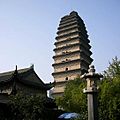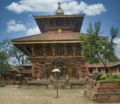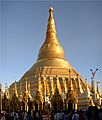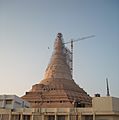Pagoda facts for kids
A pagoda is a special kind of tower with many eaves (the parts of the roof that stick out). You can find them mostly in eastern and southeastern Asia.
Most pagodas are built for religious reasons. They are usually Buddhist temples, but some are also used by Taoists.
The idea for modern pagodas came from ancient buildings called stupas in Nepal. These were first built over 2,300 years ago. This type of building spread across Asia, changing its look in different regions.
Stupas were used to keep important Buddhist items called relics. Later, the design of Chinese towers and pavilions mixed with the stupa style. This new design then spread to Southeast Asia. The main purpose of a pagoda was to hold relics and sacred writings.
Contents
Pagoda Design
Pagodas come in many sizes. The very tall ones often get hit by lightning. Because of this, people used to believe the pointy top part (called a finial) could catch evil spirits! Today, many pagodas have special wires that act like lightning rods to protect them.
Most pagodas have an odd number of floors. One famous exception is a pagoda in Royal Botanic Gardens, Kew in London, which was built in the 1700s.
Pagodas in countries like Myanmar, Thailand, Laos, and Cambodia look very different from those in China and Japan. Their designs come from an older style called Dravidian architecture.
Building Materials
Wood Pagodas
In ancient China, during the Southern and Northern Dynasties period, most pagodas were made of wood. Many other old Chinese buildings were also wooden. Wooden pagodas are good because they can handle earthquakes well. However, many have burned down over time, and wood can also rot or get eaten by insects.
Some examples of old wooden pagodas include:
- The White Horse Pagoda at White Horse Temple in Luoyang.
- The Futuci Pagoda in Xuzhou, built around 220–265 AD.
Many wooden pagodas from the Northern Wei period are mentioned in old writings, but they no longer exist. The oldest wooden pagoda still standing in China today is the Pagoda of Fugong Temple in Shanxi Province. It was built in the 11th century.
From Wood to Brick and Stone
Around 386–618 AD, during the Northern Wei and Sui periods, people started trying to build pagodas with brick and stone. But wood was still the most common material. For example, Emperor Wen of Sui ordered many wooden pagodas to be built, but none of them survived. Only the Songyue Pagoda, a stone pagoda built in 523 AD, is still standing from that time.
Brick Pagodas
The oldest brick pagoda still standing is the Songyue Pagoda in Henan, China. It's about 40 meters (131 feet) tall and has a round base. It was built in 523 AD and has lasted for 1,500 years! Like later pagodas, it has many roofs (eaves) around its sides and a spire at the top. Its walls are 2.5 meters (8 feet) thick. Another early brick pagoda is the Guoqing Pagoda, built in 597 AD.
Stone Pagodas
The first large stone pagoda is the Four Gates Pagoda in Shandong, built in 611 AD during the Sui Dynasty. It also has a spire at the top and is built in a style called the pavilion style.
Brick and Stone Together
One of the first pagodas made of both brick and stone was a three-story building from the Jin Dynasty (265–420 AD). However, it is now destroyed.
Brick and stone became the main materials for building pagodas during the Tang, Song, Liao, and Jin dynasties. A famous example is the Giant Wild Goose Pagoda, built in 652 AD. The Porcelain Tower of Nanjing was also a very famous brick and stone pagoda in China.
Pagodas Change Their Place in Temples
Until the Sui and Tang dynasties, pagodas were usually placed in the center of temples. This was like the tradition of the White Horse Temple. But during the Tang Dynasty, the main hall of the temple became more important. So, the pagoda was moved to the side of the hall, or sometimes even outside the temple area completely.
Later, in the Song Dynasty (960–1279), a new temple design was created that didn't include pagodas at all. Even so, large pagodas were still built, but usually outside the main temple area.
Styles of Different Eras
Han Dynasty Towers
Before Buddhist ideas and full pagodas came to China, the Han Dynasty (202 BC – 220 AD) already had tall towers. These towers were used for religious purposes, as observatories to watch the stars, as watchtowers, or as fancy buildings to please spirits and gods.
-
An ancient Chinese model of two towers, made of clay during the Han Dynasty (2nd century BC to 2nd century AD).
Sui and Tang Dynasty Pagodas
Pagodas built during the Sui and Tang periods usually had a square base. The Daqin Pagoda is one of the few exceptions.
Dali Kingdom Pagodas
Song, Liao, Jin, Yuan Dynasty Pagodas
Pagodas from the Five Dynasties, Northern and Southern Song, Liao, Jin, and Yuan Dynasties introduced many new styles. They often had hexagonal (six-sided) or octagonal (eight-sided) bases.
-
Pagoda of Fogong Temple, built in 1056 AD.
-
The Liaodi Pagoda, built in 1055 AD.
-
Pizhi Pagoda, built by 1063 AD.
-
The Chengling Pagoda, built in 1189 AD.
Ming and Qing Dynasty Pagodas
Pagodas from the Ming and Qing Dynasties generally followed the styles of earlier times, with only small changes.
Famous Pagodas
Here are some notable pagodas, which are tiered towers with many roofs:
- Dâu Pagoda in Vietnam, built in 187 AD.
- Pashupatinath Temple in Nepal, built in the 5th century.
- Trấn Quốc Pagoda in Vietnam, built in 545 AD.
- Songyue Pagoda in China, built in 523 AD.
- Mireuksa in Korea, built in the early 7th century.
- Pagoda at Hōryū-ji in Japan, built in the 7th century.
- Giant Wild Goose Pagoda in China, built in 704 AD.
- Small Wild Goose Pagoda in China, built in 709 AD.
- Seokgatap and Dabotap in Korea, both built in 751 AD.
- Tiger Hill Pagoda in China, built in 961 AD.
- Iron Pagoda of Kaifeng in China, built in 1049 AD.
- Pagoda of Fogong Temple in China, built in 1056 AD.
- Porcelain Tower of Nanjing in China, built between 1402 and 1424 AD. It was considered a wonder of the medieval world.
- Tsui Sing Lau Pagoda in Hong Kong, built in 1486 AD.
- Pagoda of the Celestial Lady in Vietnam, built in 1601 AD.
- Tō-ji in Japan, the tallest wooden structure in Kyoto, built in 1644 AD.
- The Great Pagoda at Kew Gardens in London, UK, built in 1762 AD.
- Reading Pagoda in Pennsylvania, USA, built in 1908.
- Kek Lok Si's main pagoda in Malaysia, built in 1930, shows a mix of Chinese, Burmese, and Thai styles.
- Pagoda of Tianning Temple in China, completed in 2007, is the tallest pagoda in the world at 153.7 meters (504 feet).
- Sun and Moon Pagodas in China, twin pagodas on a lake, reconstructed in 2001.
Some Stupas are also called "pagodas":
- Global Vipassana Pagoda in India, the largest stone dome in the world without support beams.
- Shwedagon Pagoda in Myanmar, a 98-meter (321 feet) tall golden pagoda. It is very sacred to Buddhists in Myanmar and holds relics of past Buddhas.
- Uppatasanti Pagoda in Myanmar, a 325-foot tall landmark built from 2006 to 2009.
Buildings that look like pagodas but are not traditional ones:
- The Dragon House in Germany, an 18th-century building that tried to copy Chinese architecture.
- The Panasonic Pagoda at the Indianapolis Motor Speedway in the USA, a 13-story control tower.
- Jin Mao Tower in Shanghai, China, built between 1994 and 1999.
- Petronas Towers in Kuala Lumpur, Malaysia, which were the tallest buildings in the world from 1998 to 2004.
- Taipei 101 in Taiwan, which was the world's tallest building in 2004.
Images for kids
-
The Liuhe Pagoda (Six Harmonies Pagoda) in China, built in 1165 AD.
-
Giant Wild Goose Pagoda in China, built in the 7th century, made of brick.
-
Seokgatap of Bulguksa in South Korea, built in the 8th century, made of granite.
-
The Lingxiao Pagoda of Zhengding, Hebei, built in 1045 AD.
-
The Xumi Pagoda, built in 636 AD.
-
Floor-support structure in a corner of the Horyuji temple in Japan.
-
The Iron Pagoda of Kaifeng, China, built in 1049 AD.
-
One Pillar Pagoda, Hanoi, Vietnam.
-
The nine-story Xumi Pagoda, Hebei, China, built in 636 AD.
-
Taipei 101 in Taipei, Taiwan.
-
The Bombardier Pagoda at the Indianapolis Motor Speedway.
-
Shwedagon Pagoda in Yangon, Myanmar.
See also
 In Spanish: Pagoda para niños
In Spanish: Pagoda para niños













































